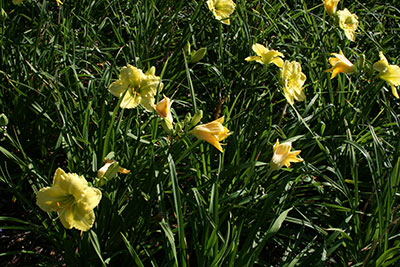The daylily is a popular flowering perennial that adapts well to Florida landscape statewide. Plants are available in a wide variety of growth habits, flower shapes and colors, including yellow, orange, red, pink, and purple, near white and shades and combinations of all of these. Flowering starts in March for early-season bloomers while late-season daylilies won’t bloom until mid-May. Select early and late-season bloomers to extend the flowering season. The typical bloom period is about four to seven weeks, although some varieties bloom even longer.
Daylilies are members of the lily family, in the genus hemerocallis; “Hemero” is Greek for “day” and callis for “beauty”. The flower buds and petals are edible raw, boiled, stir-fried, steamed, or batter and fried. Dried daylily petals, call “golden needles”, are used in numerous Chinese dishes. The modern varieties of daylilies have been developed from native Chinese spices. Early settlers from Europe and Asia brought many of the original species with them to America. During the last 75 years, hybridizers in the United States and England have made great improvement in daylily varieties.
Raising daylilies is fairly simple, but first you have to make sure you’re choosing the right varieties for our area of the state. Daylilies are classified into three groups according to their growth habits – deciduous, semi-evergreen, and evergreen.
As you might expect, the deciduous daylily varieties die back in the winter. They do well in our area. But they don’t receive enough cold weather in South Florida. On the other hand, the evergreen varieties generally grow best in areas with mild winters.
Daylilies may be planted any time of year, but hey usually do best if they’re planted right after flowering. Once they’re established, these lilies need only minimum care.
Proper planting bed preparation is a critical factor in raising daylilies. They are replanted only every five to ten years, so the flower bed needs to have a soil of good quality. The lilies grow best on a well-drained soil with good aeration and good water holding capacity. Sandy soil usually provides the necessary aeration, but they don’t hold water very well. On the other hand, clay soils have good water holding properties, but they don’t provide the aeration lilies need. If your soil is sandy, you need to add two to four inches of peat moss and work it into a depth of sixth to eight inches. If your soil has a great deal of clay in it, you might want to add about an inch of perlite or similar material to increase aeration.
Prior to planting, the flower bed should be fertilized with several inches of a good compost, or 8-8-8 / 10-10-10 mixture, at the rate of two-and-a-half pounds per 100 square feet. An inch or so of water should be applied once or twice a week until the plants are well established. Twice each year, fertilize with the same two-and-a-half pounds of 8-8-8 or 10-10-10 per 100 square feet. Apply the fertilizer evenly, keeping it off the foliage.
Daylilies have a tendency to become crowded, and when this happens, flowers production is reduced. If crowding occurs, you’ll need to divide to the plants by digging them up and severing the Rhizome between the fans of leaves with a sharp knife. Cut the leaves back to within four to six inches of the crown and replant the division.
Daylilies can be planted in a variety of ways to enhance your landscape in informal groupings, in small groups in the space between shrubs or in front of a fence or wall which will serve as a background.
- Muscadine Grape: a Popular Fruit for North Florida - August 10, 2015
- Southern Field Peas, a Summer Delight - July 14, 2015
- Caterpillars with a Sting - June 10, 2015

